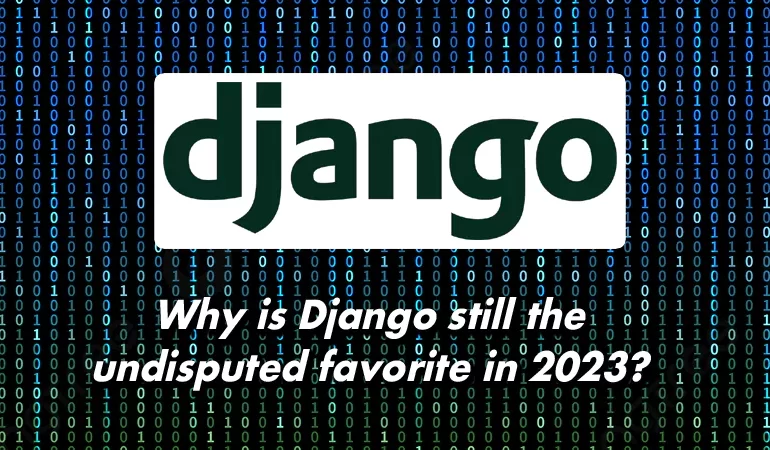For almost eighteen years, the Django framework has been one of the most beloved and in-demand tools among developers worldwide. What are the reasons for its popularity, and is it still relevant in 2023?
Table of Contents
Is Django a competitor killer?
Despite the fact that this Python language framework has nothing to do with the legendary western hero (in fact, it is named after guitar virtuoso Django Reinhardt), it knocks out its competitors with one shot, figuratively speaking. Almost any website built with Django turns out to be more feature-rich, highly secure, and productive than resources created using other tools.
Thus, Django left the once extremely popular Ruby on Rails far behind. One of the main competitors of Django in web development – PHP – simply because it has appeared much earlier, it is still the leader in the number of sites created on it. However, the trend of transferring web resources from PHP to Django has been outlined for a long time and continues dynamically currently. In 2018, 136.55 sites switched from PHP to Django, and today this number has multiplied many times over and continues to grow steadily.
Today, there are many different ways to study the popularity of programming languages and their frameworks. None of them can be considered absolute, but comparing several sources lets you see the general trend quite clearly. In particular, according to the professional community of programmers on GitHub from 2012 to 2022, Django is ranked second in popularity among back-end development environments (61,614 repository stars). It is second only to the PHP-based Laravel framework (67,902 stars). Django holds this leadership position for the third year in a row, which indicates its enduring relevance, high demand, and enduring popularity.
In early 2023, over 80,000 sites on the World Wide Web were either written entirely in Django or used its mechanisms to some extent.
What is the secret of Django’s success?
The Django framework happily combines a colossal set of outstanding features. This fact makes it the number one choice among Python tools and one of the most popular development environments in general.
To explain this phenomenon, it makes sense to elaborate on some of the components of its success.
- Being initially equipped with the necessary and sufficient set of tools and software solutions, including reliable data protection and built-in authentication tools, Django minimizes the path for developers from an idea to its implementation.
- Django is an almost perfect balance between strict development environments (that is, those that only use their native components) and overly flexible (allowing too loose code approaches and the use of third-party modules). The first option limits the programmer’s creativity and tightly ties it to a single tool. The second is fraught with errors, making the code difficult to understand for a developer who was not involved in its creation from the very beginning, and potential compatibility issues. Django is classified as a moderately flexible framework, which means that it has incorporated the advantages of both approaches, but at the same time, is devoid of the lacks of each of them.
- Products developed with Django are incredibly powerful. In support of these words, it is enough to cite this fact. Instagram, which has ten thousand servers around the world and two billion users (this figure is growing steadily), uses Django and considers it the ultimate solution.
- Django assumes unlimited scalability of applications and resources created with it. Continuing the history of Instagram, one cannot fail to mention the growth dynamics of this social network. Established in 2010, this social network reached a million users in just a few months. To date, the number of its subscribers is steadily moving towards the third billion. All this time, the stability of Instagram is ensured with the help of Django.
- Python, in general, and Django, in particular, have a relatively low barrier to entry for beginners. Due to the code’s compactness and clearness, Python language, and therefore its frameworks, is much easier to learn than, for example, PHP or C++. In addition, being extremely popular, Django has a substantial professional community. This fact means that you can always find an intelligent recommendation in case of any difficulties. Also, the presence of a multi-million army of experienced developers united by common interests allows you to expect that, most likely, the module you need has already been written, and elegant solutions have been found for complex tasks. This way, you can take advantage of the global collective intelligence instead of reinventing the wheel every time.
- Django is an almost universal solution for creating any applications, systems, and resources. In particular, with the help of this framework, streaming sites, decision-making and production management systems, e-commerce platforms, ticketing, hotel room booking services, etc., are created. Python was initially designed to work with large amounts of data, so Django is ideal for any solution involving super-volume databases and Big Data calculations.
What are the prospects for Django for the foreseeable future?
IT experts and analysts say that Django, as the leading Python framework, will remain relevant and in demand for at least the next ten years. Accordingly, specialists who mastered this language (or decided to learn it just now) and know how to work with Django will not experience problems with employment and high pay for their services.
However, suppose you are just considering which direction you should lead the development of your programming career. In that case, it is worth considering that for all the relative simplicity of the Python language, the Django framework is still a rather complex tool. Therefore, if you have not come across frameworks so far, it makes sense to learn something simpler first. In this way, you will be able to get the necessary understanding of the logic of using such development environments, and by moving to Django, you will already fully use its incredible power and almost unlimited possibilities.
Summing up
Django is an amazingly flexible, feature-packed, user-friendly, and robust tool with which you can create literally anything. Features of its architecture, in particular, a modular device, the Don’t Repeat Yourself principle, an innumerable variety of already existing modules, and much, much more – all this rightfully makes it one of the most popular development environments.
Obviously, the demand for Django has not yet reached its peak, and its relevance is steadily increasing. The future looks more than promising for Django and those who know how to work with it.
Also Read: How to: SaaS Customer Support


